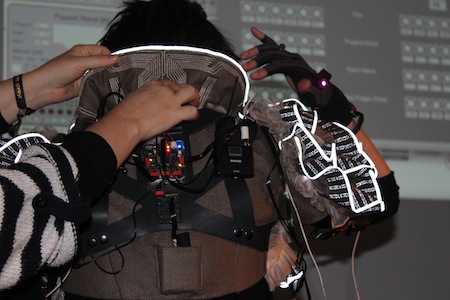how to sew the vmeter sleeve
Monday, April 1st, 2013Tim’s midi-osc article has now an explanation on How to sew the vmeter sleeve and a video which shows the wireless vmeter in action:
randformblog on math, physics, art, and design |
Tim’s midi-osc article has now an explanation on How to sew the vmeter sleeve and a video which shows the wireless vmeter in action:

artwork: “Berlin citysimbim” by glocki
This post is a kind of follow-up post to the last one, which dealt amongst others with simulations of political/economic scenarios in multiplayer online games. In a couple of days a new SimCity game will come out and as Wikipedia puts it:
This version of SimCity will be the first to feature full online play since Maxis’s SimCity 2000 Network Edition,[1] allowing for regions to house multiple cities from different players. Regions can alternatively be set to private for solo play.[31] SimCity will require players to be logged into EA’s Origin service to play the game, including when playing single player.
or as SimCity.com puts it:
SimCity has truly connected cities within larger regions for the first time. Cities do not exist in a bubble – they are living, breathing systems that make up a region – and now you can trade and share resources among cities and regions in real time.
Unfortunately the above mentioned Origin seems to have sofar stirred up a lot of controversy about privacy issues. In Europe there are currently new data protection regulations underway, which by the way seem to be heavily “informed” by lobbyists. (The website Lobbyplag (unfortunately sofar only in german) gives an overview, which law drafts have been directly pasted in from which lobbyists brochures.) In view of this ungoing process it is thus however sofar not clear wether any of the discussed privacy issues of Origin will have any or what juridicial consequences.
SimCity2013 seems to allow for no modding at least right after launch. That is in an interview with gameinformer SimCity lead producer Kip Katsarelis replied to the question:
Is there an element of user-created content and sharing in city customization?
We’re not committing to any of that at this time, but we know that is part of Maxis. In SimCity 4, a lot of those tools were released pretty much a year after launch. So, definitely on our minds, but I can’t promise that we’re delivering on any of that right now.
If modding would have been possible then -apart from eventual privacy/data protection problems- the people from the project of the last post could have eventually thought about wether it would make sense to use SimCity2013Mods for their purpose. However it should also pointed out, that even if modding would be possible then too political game mods could pose problems.
One should also think about the economic consequences of computer simulations/games etc. (you may eventually also want to read my comment on the blog Backreaction in this context.)
addition 13.12.17: For the readers convenience, here a copy of the comment on the blog Backreaction:
nad0815 said…
What you seem to be somewhat discussing is to some extend wether there exist some god(s).
That is if I replace “simulation” with “creation by god” and if I replace “computer” with “human mind accessible universe” then your discussion looks very similar to that discussion.
Finally wether something feels “simulated” or “real” is quite a question of perception. You may eventually want to read:
And since there are quite some humans who claim that they already saw/perceived/DISCOVERED the “simulator(s)” your “coincidence problem” seems to be spread over all centuries.
you wrote:
“To begin with, unless you want to populate the simulation by hand, you need a process in which self-awareness is created out of simpler bits. And to prevent self-aware beings from noting the simulation’s limits, you then need a monitoring program that identifies when the self-aware parts attempt to make an observation and exactly which observation.”
Why should self-awareness (of limitations) be necessary to simulate self-aware entities? In fact a simulation of (aware) entities could happen by un-self-awarely mimicking a construction process and/or by chance. In that case your simulation would neither be a “creation of an aware god” nor be it “fully self-organized by some abstract laws and/or random outer conditions”. And thus there seems to be in particular no reason why simulated entities need to be kept from noticing that they are simulated like in order “to save on computational power” – that is they could awarely simulate without knowing that they are simulated themselves or they could even simulate whatever while being completely unaware of whatever. Both would need calculational power.
In fact I do think that nowadays “simulations” in computer games (and related computer environments) use up a lot of power, labour, time etc. and that this seems to have already quite an economic impact:
http://www.azimuthproject.org/azimuth/show/Economic+growth+and+limitationsSo you’d never observe any effects of finite lattice spacing because whenever you look all symmetries are restored. Wicked. It also creates other scientific problems.
(short side remark: There exist of course also fractals)
Considering the alien question: The reason that we have sofar not detected any “aliens” could of course be also for the reason that mankind has sofar been regarded as a kind of “baby civilization” and has thus sofar been protected from any shocks which could result from meeting the aliens…
5:24 AM, March 03, 2013

Musician Imogen Heap in her tech wear
In a recent comment on randform randform reader Bibi asked:
You had written at Azimuth that your idea to use MMOGs for simulating economic and political real world scenarios
seems to have recently been picked up for the Global Participatory Platform of the 2013 Flagship proposal FucturICT
It seems also that your scientific platform idea had been picked up for that ICTfutur grant proposal.
What about your intellectual property?
The FuturICT application for 1 billion Euros had though been turned down, will you now write an EU grant proposal?
Answers to this comment after the click.
The informed randform reader knows that I am a proponent of open access to (up to now) mostly publicly funded academic papers with the side remark that the full access to results with possibly hazardous implications may eventually need to be treated differently. In the randform post “petition for open acess to EU research results” MIT’s open courseware was mentioned as a good example for open access. In this article it was also mentioned that
At this point one should maybe remind the EU about the benefits of open source software and communities for their research institutions. These open initiatives are supported by individuals who contribute to the community usually in their free time.
In an older randform post: focus and context, part IVa: Codes and context, based on an observation by Aaron Swartz, it was mentioned that this engagement depends on the overall living conditions of that individuals.
Given MITs engagement in open access I was now shocked to hear that MIT was apparently involved in charges against Aaron Swartz, which were made because of his release of JSTOR documents. I didn’t know that the charges could have brought him 35 years in prison – I had viewed the JSTOR-release rather as an act of a kind of civil disobedience. I also didn’t know about his apparently rather strong depressions, in fact I never met him, not even communicated with him. I am shocked and very sad to hear about Aaron Swartz suicide. My consolations to his family.
I find it quite evident that such exorbitant charges contributed to his overall psychic condition and the role of the involved institutions and people sheds no good light on them.
Nevertheless in general I think it may be important to speak out about depressions and other comorbidities of academic life (and maybe also other lifes under pressure).
But speaking out alone may – so sad and heart-wrenching – not be enough.
Thus as a consequence of Aaron Swartz death Ian Gent and Mikael Vejdemo-Johansson (via Sarah Kendrew) opened a blog called depressedacademics:
So that’s why I’m starting this blog. Academics should have a place to see other people’s stories. To see that it’s ok to be depressed. To see that it’s normal. To comment and discuss if they want. And to share resources on depression, whether related to academia or not.
…where I am not sure wether it is really good and normal to be depressed. It should also be pointed out that speaking openly out in public about disorders and sicknesses should probably made only by individuals in secure social conditions. Being open about that topic may have severe consequences on your health insurance, occupational disability insurance, work and carrier opportunities etc.
As a side note: There may be a blog freeze on randform. That is my MAC seemed to have died now for sure and I am currently writing on a borrowed one. The laptop made suddenly only more 3 beeps while trying to boot, a signal which means “no good banks”.
the post au courant got a little addition in order to make it more au courant.
Some friend must have forgotten his/her keyring on our kitchen table. For those who have visited us: Please have a look at the images after the “read the rest of the entry” and let us know wether you miss it.
Tanz im Aufbauhaus inspired by 90’s hip hop music, Klaus Nomi, Kraftwerk, Nina Hagen and the Megaphoneannouncements at S-Bahnhof Friedrichsfelde-Ost.
The song is about humans and machinization. Translation eventually later.
After the click some infographics which illustrate the german Reformvorschläge (in german).
(more…)

monsters from a 9 yr. old, more images after the text
randform reader spitzketreiber wrote in a comment to the last blog post:
so you don’t want to mingle your kid with the normal kids in that school, isn’t that elitistic and in contradiction to the egalitarian views you expressed here on this blog?
What do you mean with egalitarian? I think every human has the right for half-way decent living conditions that is in particular everybody should have access to food, housing, education and health care, but thats not egalitarian as in the usual sense.
Moreover I didn’t say that I don’t wan’t to mingle my kid with the “normal” kids.
On the contrary. I do think that it can be good to bring rather different types of kids together. However the size of the classes and the ratio of teachers and or supervisors/social workers to pupils/group members matter a lot if you have different types of pupils/group members. I worked in the early eighties in a preschool where disabled, mentally retarded and “normal” children were brought together in one group. I found it was for all children a win. However for this project the ratio of teacher/supervisor/kid was about one teacher for 1-2 kids and this ratio was definitely necessary.
In general it is important that each kid has something to work on, something were it can grow its abilities. If you have a group of very different kids it is often not so easy to find the right means to realize this.
Like in the case of specific mind tasks you have to keep the intelligent kids busy enough with suited and meaningful tasks so that they don’t start to get too bored. Likewise slower kids need to get a task, which is adapted for them, a task were they feel not swamped and were they have enough freedom to work at their pace. Alpha animals have to be often kept at distance, cultural obstacles have to be resolved, some people need a special amount of physical workout, some people talk a lot, some people are better able to adapt etc. In general one can say the more different a group, the harder it can be to “keep the group together” for a longer time while simultanously get some work done with some portion of efficiency. Moreover with a smaller teacher/kid ratio the evaluation of abilities is more difficult. So it may happen that very different people supplement each other and may easily form a group however in the generic case one can rather observe that often either people sort themselves (“social segregation”) or that they are sorted prior to forming groups and/or that they are “streamlined” via pressure and rules (please see also the comment on the moderation of groups). Thus school classes are e.g. formed by sorting via grades and/or other aspects, like tuition etc. The bigger the classes, the less teachers there are, the more streamlining and sorting may be necessary in order to keep a certain standard. Ever done chemistry experiments with a bunch of over 30 ten year olds in a small room? I did this and I can say it can be challenging.
In a lot of the Berlin gymnasia which are mentioned in the previous blog post there seem, at least by what we have heard, to be less social and cultural differences than in that gymnasium in Marzahn-Hellersdorf at which our kids are currently. In that sense it seems the social and cultural components of difference may be lower in these schools then in this school in Marzahn-Hellersdorf and thus if you have the same amount of too many pupils this may be a learning advantage.
In the case of our son we thus have – apart from the Berlin-Bavarian problem with spanish as a second language (which wouldn’t be resolved by sending him into a “normal” class at this school and I am still quite angry that they didn’t tell us when we applied for that school that french is going to be eliminated) – to figure out wether it is better for our son to stay in his “presorted” class with a higher teacher ratio per kid, however with a higher teaching speed (“fastgoerclass”) or to change to a rather crowded class with probably more tensions due to more and more different pupils. I should also say that depite the fact that his class was already more “sorted” than a “normal” class (kids in these kind of classes have often parents which have a high interest in good education) there were already big overall tensions (especially among the boys) and that the math teacher spend his free time to speak with the boys and to establish a kind of anti-bullying system. One should also mention that the school had to undergo a major restructuring and that there is a rather high fluctuation of teachers, because of e.g. changing pupil numbers, the restructuring and school reforms. So for example my daughters class has now the fifth math teacher (temporary staff not included) in four years. Moreover an overall higher teaching speed (as said the gymnasia in Germany were roughly shortened by a year in recent times) together with higher challenges of a technological society put additional pressure on schools and kids. This school in Marzahn-Hellersdorf has some excellent teachers and it is frustrating to see how they are struggling. There was recently also a study, which displayed that the current german school system produces a lot of “loosers”, from the article Deutschland, Land der Schulabsteiger
“Selbst in Sachsen, dem informellen Sieger der neuen Studie, kommen auf einen Schulaufsteiger elf Schüler, die aus dem Gymnasium in eine niedrigere Schulform herabgestuft werden. In Niedersachsen sind es 12, in Berlin gar 14.”
translation without guarantee:
Even in Saxonia, the informal winner in the study, it was that for one fast climber there are eleven pupils which are decending from Gymnasium into a lower school form. In Lower Saxonia there are 12 and in Berlin even 14.
Big classes are of course motivated by economic considerations and similar dynamics with high teach speed and bigger “classes” take place in higher education. For example a year and a half ago Tim had to give lectures in front of about 1000 ! students – he had already to think about wether it may be necessary to split his lecture via a video screen into two lecture halls. I call this an academic Musikantenstadl.
The New York times had recently an article which conscisely summarized two major components of these dynamics. One effect is the socalled “Baumol’s disease”:
Some of that growth has resulted from a phenomenon called Baumol’s disease, after the economist William J. Baumol, who described it in a 1965 article he wrote with William G. Bowen. The basic idea is that while productivity gains have made it possible to assemble cars with only a tiny fraction of the labor that was once required, it still takes four musicians nine minutes to perform Beethoven’s String Quartet No. 4 in C minor, just as it did in the 19th century.
College instruction more closely resembles a musical performance than an auto assembly line. Although information technologies have yielded some productivity growth in academia, instruction still takes place largely as it always has.
In some sense one can see this dynamics as a indication that humans (the training of, the maintanance of etc.) are loosing against the market competivity of machines and this is not only the case for the industry sector but increasingly also the case for the socalled knowledge economy. Note in particular that teaching becomes especially part of the monetarily sucessful section of knowledge economy if it is not mainly concerned with teaching “mentally weak” humans (or whoever appear as such) but humans which are able to construct, run and maintain high tech, i.e. “machines.”
This becomes also apparent in the second phenomenom which lies according to the New York times in “prestige hunting” (and the corresponding tuition costs):
“After adjusting for inflation, starting salaries for most graduates have remained essentially stagnant for several decades, while those at the bottom of the group have actually declined. Only the highest-paid graduates have enjoyed significant salary growth, and among those a very thin slice at the top has seen truly spectacular increases.
Because of the bitter competition for those premium salaries, elite educational credentials are often a precondition for even landing a job interview. With so many applications for every vacancy, many consulting firms and investment banks, For example, now consider only candidates from a short list of top-ranked schools.”
That is consulting firms and investment banks are of course to a great extend part of what can be seen as “knowledge economy”, in particular sophisticated financial instruments make extensive use of computers, i.e. “machines” and the humans, which are assumed to be able to create e.g. the best computer programs and financial models are thus more sought after.
More components like growing social inequalities and declining ressources play of course also a role.

car and gadget design from a 10 yr. old
This post is a follow-up to the last post. There is also a copy of this essay at the Azimuth project.
If you read the essay you will in particular understand that I profoundly disagree with most of the key concepts as formulated in the video by Kirby Ferguson, who also investigated intellectual property in the context of evolution.
Feb22: some additions to the essay in orange more additions eventually on Azimuth
(more…)